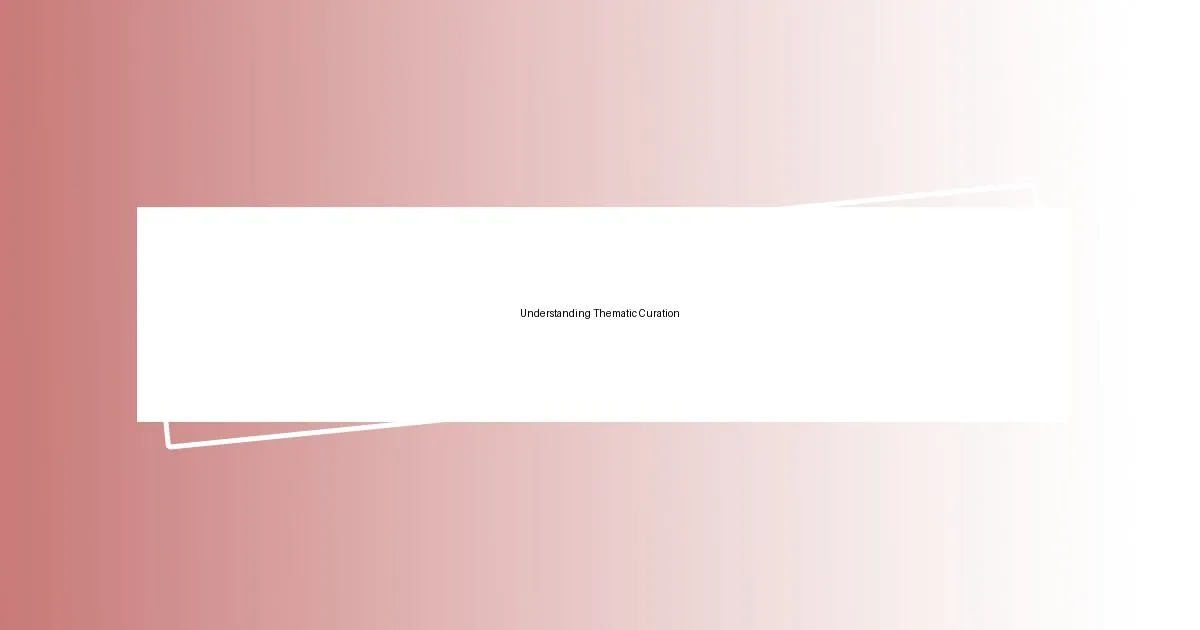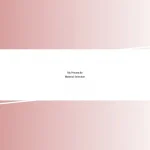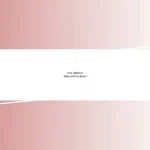Key takeaways:
- Thematic curation aims to create emotional connections and a cohesive narrative through art, enhancing the audience’s experience and engagement.
- Defining a curatorial approach blends personal experience with analytical thought, prioritizing storytelling over traditional aesthetic values.
- Active audience engagement is crucial, using feedback and interactive elements to foster deeper connections and enrich the overall experience.
- Future directions in thematic curation include leveraging technology and community collaborations to create immersive, inclusive experiences and lasting discussions.

Understanding Thematic Curation
Thematic curation is more than just organizing content; it’s about weaving a narrative that resonates with an audience. I remember a time when I curated an art exhibit centered around emotions—fear, joy, and nostalgia. The process was eye-opening; I realized that the themes not only guided the selection of artworks but also created an emotional experience for visitors.
Have you ever found yourself captivated by a collection of similar stories or visuals? That’s the magic of thematic curation. It’s about finding those threads that connect seemingly disparate pieces into a cohesive whole. For me, it’s like solving a puzzle, where each element contributes to a grander narrative.
When I first started curating, I often felt lost among the vast array of choices. How do you sift through endless possibilities to find what truly inspires? Over time, I learned that thematic curation allows for a deeper exploration; it invites both the curator and the audience to engage actively with the content, uncovering layers of meaning together.

Defining My Curatorial Approach
Defining my curatorial approach involves a blend of intuition and analytical thought. When I carefully select pieces for a theme, I often rely on my personal experiences and emotions that those pieces evoke in me. For instance, during a recent project focused on identity, I chose artworks that not only represented diverse backgrounds but also resonated with my journey of self-discovery. Each selection felt like a step into a dialogue that I wanted to facilitate with the audience.
In terms of methodology, I contrast traditional curation with thematic curation. Traditional curation tends to focus heavily on aesthetic value or historical significance, whereas thematic curation allows for more personal connections and storytelling. I find this approach liberating; it encourages me to probe deeper into what each piece signifies and how it relates to the broader theme. It’s not just about placement—it’s about creating a shared understanding and emotional resonance.
Additionally, I’ve found that my stylistic choices directly influence viewer perception. For example, I recently experimented with juxtaposing modern pieces against classical ones. The reaction from visitors was astounding; they articulated feelings of conflict that made sense of their own experiences. This hunch reaffirmed my belief that my curatorial approach is not static—it’s dynamic and continually evolving through interaction and feedback.
| Traditional Curation | Thematic Curation |
|---|---|
| Focus on aesthetics and historical context | Pursues storytelling and emotional resonance |
| Static methodology | Dynamic and interactive process |
| Limited personal connection | Encourages personal dialogue with the audience |

Exploring Key Themes and Trends
Exploring key themes can be a fascinating yet challenging endeavor. One theme that has consistently resonated with me is the concept of time. In my last curation, I selected pieces that spanned different eras, creating a dialogue between past and present. The reactions from visitors were robust; some shared personal stories tied to the artworks, linking their own experiences with historical contexts. It reminded me just how transformative examining time can be, and how this theme encourages a reflective space.
Here are a few other trending themes I’ve noticed in my work:
- Identity: Explores personal narratives and cultural backgrounds, prompting deep connections.
- Nature and Environment: Highlighting ecological awareness, it encourages dialogue about sustainability.
- Technology and Disconnection: Articulating feelings around virtual interactions versus physical connections feeds into contemporary discourse.
- Mental Health: Promoting awareness and understanding, many artists are expressing their journeys through emotion and resilience.
- Social Justice: This theme fosters community engagement, urging visitors to reflect on societal issues through powerful visual storytelling.
Each theme not only enhances understanding but also cultivates a shared journey for both the curator and the audience. I find that the more I delve into these themes, the more avenues for conversation and connection open up, whether it’s through shared frustrations about social issues or joy found in the intricacies of identity.

Building a Diverse Content Collection
Building a diverse content collection requires listening to varied voices and perspectives. When I embarked on a project highlighting cultural narratives, I sought out artists from underrepresented communities. I remember one particular piece that drew me in—a vibrant tapestry that wove together stories of migration and belonging. It was a reminder that every piece brings its own story, enriching the overall narrative of the collection.
I’ve found that collaborating with artists and community members adds layers to my thematic curation. Recently, I reached out to a local group focused on social justice. They shared passionate insights about how art reflects their struggles and triumphs. This interaction didn’t just shape my collection; it deepened my understanding of the broader societal context, turning a selection of artworks into a collaborative tapestry of voices and experiences.
Fostering diversity also means being open to challenging the status quo. I often ask myself, “What perspectives are missing from this collection?” Addressing this question has led me to include works that provoke thought and ignite discussions—pieces that might initially seem jarring but ultimately resonate on a human level. My aim is to ensure that each artwork not only exists in isolation but contributes to a richer conversation, leading to a more inclusive and engaging experience for all who encounter it.

Engaging with the Audience
Engaging with the audience is not just about presenting art; it’s about fostering a connection. I recall a moment at an exhibit where one visitor expressed how a piece mirrored her own journey of self-discovery. This interaction sparked a heartfelt discussion, revealing how deeply personal experiences can resonate with collective themes. It’s fascinating how a single artwork can evoke such powerful emotions and conversations, transforming a quiet gallery into a vibrant space of shared narratives.
Listening to audience feedback is invaluable for my curatorial process. For instance, during a community workshop last year, someone suggested integrating local history into our next project. This idea led to an exhibition that not only showcased artistic talent but also celebrated the local culture. I was amazed at how invested the community became, attending events and sharing their stories. This not only enriched the experience for them but also for me as a curator, reinforcing the importance of audience involvement in shaping truly engaging thematic work.
I often wonder how I can push the boundaries of engagement further. Do visitors feel seen and heard within the artworks? To explore this, I’ve started incorporating interactive elements—like live Q&A sessions with artists or hands-on workshops. These experiences have illuminated new perspectives and created an atmosphere of collaboration. Each engagement feels like a growing conversation, making art not just an exhibition but a shared journey.

Measuring Impact and Success
Measuring impact and success in thematic curation goes beyond mere attendance figures; it’s about the experiences created. I vividly recall after a major installation opened, I received a flurry of emails from visitors describing how the pieces resonated with their life stories. One note stuck with me—an attendee wrote that a particular installation helped her process grief in a way she never expected. It’s these individual stories that truly illustrate the transformative nature of our work.
I also find it crucial to set qualitative metrics to gauge success. For instance, I’ve started conducting post-event surveys where visitors can share their feelings and insights. This feedback has taught me that the magic often lies in the unexpected connections made. A casual chat with a visitor revealed that they bonded with a stranger over a piece of art, which sparked a long-lasting friendship. Isn’t it incredible how art can act as a catalyst for human connection?
Moreover, I frequently reflect on the long-term effects of my exhibits. Have they prompted any shifts in community perspectives or inspired local initiatives? After one project focused on environmental issues, several attendees became advocates for sustainability in their neighborhoods. It gave me a sense of fulfillment, knowing that our curated space transcended the gallery and made a tangible impact in the community. Ultimately, I measure success by those ripples of change we create, sparking conversations that carry on well after the exhibition closes.

Reflecting on Future Directions
As I look ahead in my journey of thematic curation, I can’t help but wonder about the evolving role of technology in our field. Recently, I experimented with virtual gallery tours and was pleasantly surprised by the engagement they generated. It brought art to a broader audience, and seeing people from different corners of the world connect over shared art experiences was powerful. What if the next step could involve augmented reality, creating dynamic, immersive experiences that let viewers interact with the art in ways we haven’t yet imagined?
I also see potential in deepening collaborations with diverse communities, not just to showcase their narratives but to empower them as co-curators. During a recent project, I partnered with a local youth group who brought forth their ideas, leading to a vibrant display that was truly reflective of their voices. Their excitement was palpable, reminding me that when we actively include underrepresented communities, we spark a creativity that transcends traditional boundaries—don’t we all want to see art that truly feels like ours?
Ultimately, I believe my future direction will focus on sustainability, not just in terms of resources but in fostering enduring discussions. A conversation I had with a fellow curator about the importance of artworks that inspire action has stuck with me. It made me consider whether my exhibitions could be springboards for ongoing community engagement. How can I create not just fleeting moments of connection but lasting movements that challenge and inspire? These questions ignite my passion for thematic curation, driving me to explore new horizons.














